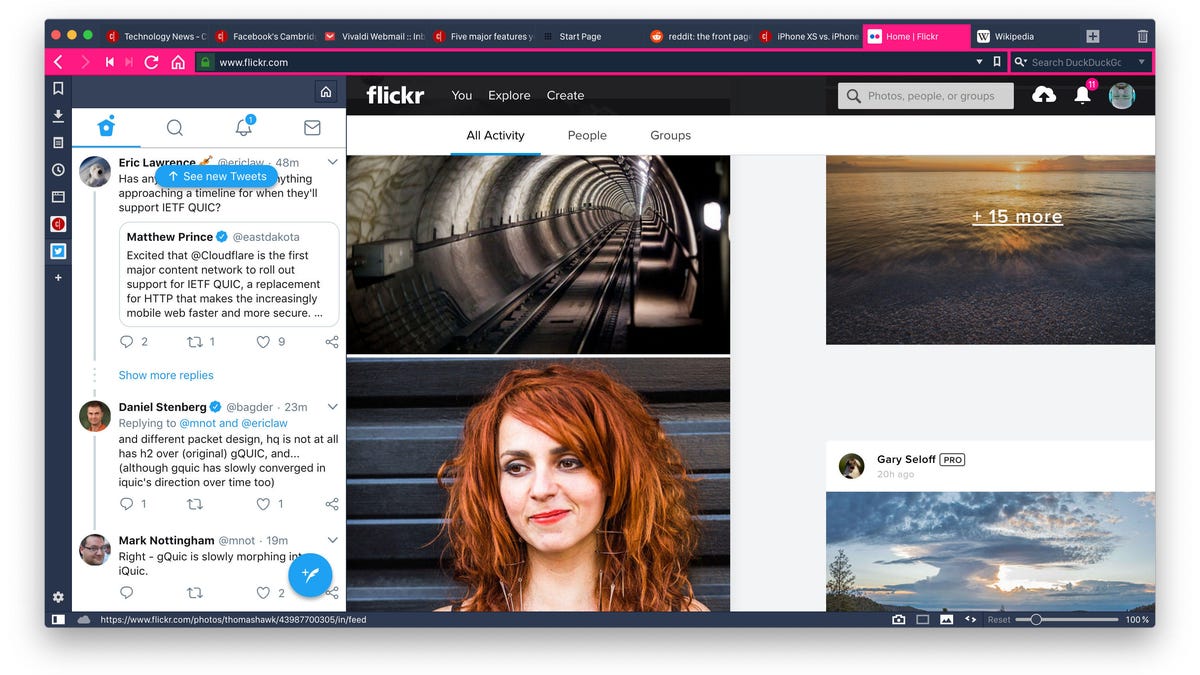Vivaldi 2.0 browser brings sync, themes and new Chrome-conquering ambitions
But there's still no version for smartphones.

Vivaldi 2.0 themes can mimic the color scheme of the website you're visiting -- in this case Flickr -- while web panels on the left can give you a quick look at websites like Google Translate, Twitter or whatever else you like.
If you want to step back from Chrome , the Vivaldi alternative browser just grew up a notch with the addition of cross-computer sync and other improvements in version 2.0.
Vivaldi, with about 1 million people using it each month, doesn't have anything like the visibility or clout of Google's Chrome, Mozilla's Firefox or Apple's Safari. But if you're looking for something different -- especially lots of customization -- it can be worth a look with the new version released Wednesday.
Vivaldi lets you fine-tune tabs, set mouse gestures and keyboard shortcuts, peer at the details of images, and eventually will even have built-in email software.
"Anyone who spends a lot of time on the internet will have a significant benefit from using Vivaldi," said Chief Executive Jon von Tetzchner, who helped launch another alternative browser, Opera, in the 1990s.
When Chrome launched a decade ago, the idea of making a competitor to incumbent powers like Microsoft's Internet Explorer or Mozilla's Firefox was pretty radical. With Chrome now dominant, though, new browsers are springing up like mushrooms after rain -- and doing so with direct help from Chrome's own open-source software.
Besides Vivaldi, browsers from Brave, Baidu, Samsung , Opera, Yandex and DuckDuckGo are built atop Chrome's underpinnings. Even Microsoft reuses Chrome for its Android browser.
New in Vivaldi 2.0
Vivaldi arrived first as a test version in 2015 and reached version 1.0 in 2016. Among the features in Vivaldi 2.0:
- Sync to keep your bookmarks and passwords linked across multiple computers, although mobile versions for Android
phones
or
iPhones
still aren't available. Sync was the top-requested improvement.
- A new theme tool to change the browser's look, including customization tools. Themes can be set to reflect the color scheme of the website you're using, and you can set them to change automatically at different times of day.
- An updated "web panels" strip down the side of the browser that offers quick access to things like downloads, notes, browsing history and websites you've pinned to it. The browser will suggest adding new entries for websites you visit often, too.
- And performance improvements under the hood, especially for people with lots of personal information like bookmarks and downloads, von Tetzchner said.
Vivaldi now synchronizes bookmarks, passwords, autofill data, notes you've made on websites, and web address you've typed, Vivaldi programmer Julien Picalausa said in a blog post Wednesday. In the future, he hopes Vivaldi also will be able to sync themes, settings, browsing history and web panel settings.
You want to tweak your browser? This is just the options available for configuring how Vivaldi handles browser tabs.
Vivaldi already offered lots of other interface differences from most browsers, including a split-screen view so you can see two tabs at once; a calendar-like interface to see what websites you visited on what days; the ability to put tabs on the top, bottom, or either side; and some privacy-focused features.
"I don't really think the building of profiles is a good idea. We do not engage in that," von Tetzchner said. He'd like to see regulations curtailing the tracking of our behavior online. "The internet was working just fine before the creation of superprofiles and using big data and AI to target individuals or groups of people."
Growing business, mobile delays
Vivaldi has grown to 44 employees. The company has surpassed its goal of generating $1 per user per year, von Tetzchner said. At that revenue rate, the company needs 3 million to 5 million people using it to become profitable.
Vivaldi's browser logo.
"It's looking good," von Tetzchner said.
However, the number of Vivaldi users hasn't changed much since mid-2016, when he said there were nearly 1 million. And another new alternative browser, Brave, is at 4 million monthly users.
Vivaldi makes money from deals with search engines that share a portion of ad revenue and from promotional placement of websites on the default new-tab page. That page can be customized to show what you want.
Vivaldi wanted to release a mobile version of its browser in 2017 but missed that deadline. "We definitely were hoping we would be moving faster, but sometimes it takes longer than expected," he said.
Vivaldi's email service is live -- indeed, you need an account to use Vivaldi's new sync tool so the browser can encrypt data without the company itself being able to see it -- but Vivaldi's email software isn't yet done. Von Tetzchner uses the prototype version himself, but it still has some "loose ends," he said. When it's done, it'll be much better than conventional web-based email, especially for people who wrestle with multiple email accounts, he said.
But for now, he's counting on Vivaldi 2.0 to attract new fans.
"This is our second big release. It's a big deal," von Tetzchner said. "Every time we do releases it gets more users, and the bigger releases do more."
First published Sept. 26, 12 a.m. PT.
Update, 10:57 a.m. PT: Adds further details about sync technology.
The Honeymoon Is Over: Everything you need to know about why tech is under Washington's microscope.
Infowars and Silicon Valley: Everything you need to know about the tech industry's free speech debate.

